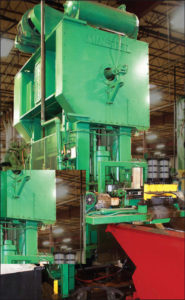Replacing a mechanical clutch, the oil sheer technology supplies constant, reliable tension on the stock feeding a 400-ton press to deliver precision and repeatability.
In the metal stamping business, precision, repeatability, and uptime are key. But stamping accuracy suffers when improper tension on the coil feeders incorrectly supplies metal to the presses, resulting in off-spec parts and increased rejections. ART Technologies of Fairfield, OH, relies on an oil shear clutch brake to supply constant, reliable tension on the coil feeding to one of its 400-ton presses to produce the precision and repeatability it needs, with no downtime for maintenance or adjustment. When the plant is working 20 hours a day, that uptime is as critical as the tolerances it maintains.
ART Technologies is a full-service global supplier of precision metal stamping components, thrust bearings, and coining services for raceways and washers. With 11 presses ranging in size from 45 to 800 tons, it stamps out a wide range of products for the automotive, truck, bus, solar, HVAC, agriculture, defense, and other industries.
The company currently operates a single shift, but when business demands it operates two 10-hour shifts, or nearly around the clock. Whether cranking out miniature thrust bearings for the automotive industry or thick stampings for the truck market, repeatability is key in all that it does.
A Pressing Problem
One of ART Technologies’ Minster 400-ton presses has a ½-HP motor that pulls the stock strip though the press, keeping tension on the steel at all times (Figure 1). This tension is a necessity because of the die design, and ensures consistency of the stamped product and optimal productivity.
Engineering Manager Fred Meinhardt explains that “we need to keep tension on the stock and to be able to run the drive unit at a speed slightly faster than the feed, so that when the feed stops, the clutch slips. When the feed restarts again, the stock tensioner takes up the slack and keeps tension on the stick as it moves forward.”
The company had been using a mechanical clutch that was slipping all the time and produced unsatisfactory results, including feed problems, out-of-spec parts, and press downtime. In addition to the production problems, the dry friction clutch would wear and require adjustment, maintenance, or replacement that consumed four to five hours per week. According to Meinhardt, the production loss due to downtime was 20%.
Excessive Downtime
Meinhardt estimates that the old-style clutches were replaced every six months or so, in addition to the four to five hours per week of maintenance. At the time, the plant was working two 10-hour shifts, so that level of weekly downtime for maintenance and adjustment was substantial and unacceptable. To top it off, the extra time to replace the clutch-brakes was even more troublesome, because the failures rarely occurred at convenient times.
The company turned to Force Control Industries, Fairfield, OH, manufacturer of the oil shear clutch brake. Installing the oil shear clutch was not difficult and reaped a significant return on investment. In the two years that the Posidyne® 1.5 clutch brake has been installed on the ½-HP motor to tension the coil stock, there has been no unscheduled downtime for maintenance or repairs (Figure 2). At two years and running, the Posidyne 1.5 has already lasted four times longer than the dry clutch, and is still working fine.

